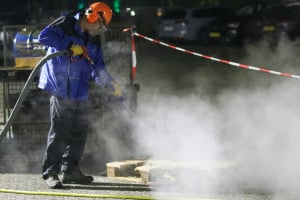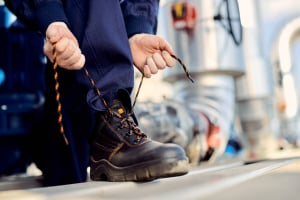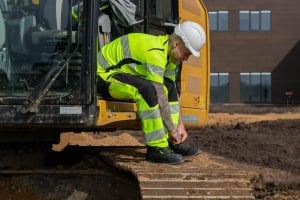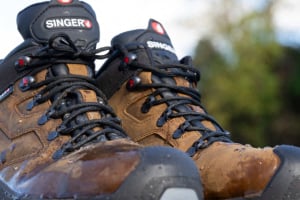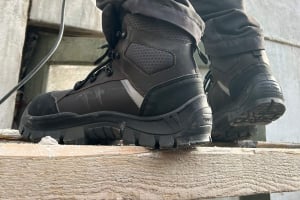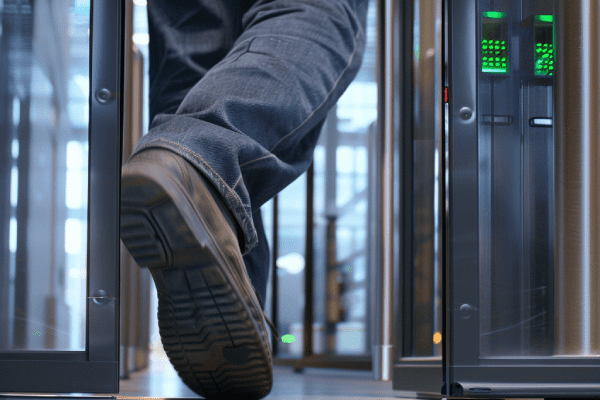
Which safety shoes do not ring the doorbell: metal-free shoes
In the professional world, safety in the workplace is essential. This includes wearing suitable equipment, such as safety shoes. However, for those who regularly pass through security gates, standard footwear can be problematic, triggering unnecessary alerts. Fortunately, a solution exists: metal-free safety shoes. Let's see together why they represent a wise choice.
Summary
Why choose metal-free safety shoes?
Advantages of metal-free shoes
In many professional environments, passing through a security gate several times a day is a mandatory routine. Traditional safety shoes, equipped with metal reinforcements to protect the feet, can often set off metal detectors, causing delays and inconvenience. In addition to these interruptions, the added weight of the metal can increase fatigue, a significant factor for workers who spend long hours standing or moving. The solution then lies in metal-free safety shoes, which on the one hand do not ring at security gates, and on the other hand, are lighter and more pleasant to wear on a daily basis.
The different metal-free protection zones
These shoes do not compromise your safety. Modern technologiesuse a variety of innovative materials to providecomplete protection. For the protective toe cap, anti-perforation plate, and arch support, materials such as composite, reinforced plastic, and Kevlar are used. Each of these materials is chosen for its specific properties, thus offering strength and lightness, equivalent to or surpassing the strength of metal, for optimal protection in various working environments.
How do metal-free safety shoes work?
Technology and materials used
The development of metal-free safety shoes is a great example of innovation in the field of personal protection. Manufacturers use various advanced composite materials to replace metal while providing equivalent or better protection. Among these materials, we find:
- Carbon fibers: Lightweight and extremely robust, they provide protection against impacts to the forefoot.
- Kevlar: Well known in the manufacture of bulletproof vests, Kevlar is used for puncture resistance.
- Reinforced plastic: Used for anti-puncture plates, this material provides solid protection without the weight of metal.
These material innovations not only match the performance of metal components; they surpass them in many aspects, notably in terms of comfort, weight, and electrical non-conductivity, while maintaining optimal protection against professional risks.
Certification and safety standards
To be considered true protective equipment, these metal-free shoes must meet not only the standards specific to their metal-free design, but also classic standards applicable to all safety shoes.This includes ISO and EN standards, in particular EN ISO 20345, which establish rigorous criteria for resistance to impact, puncture, and other occupational hazards. These certifications ensure that footwear provides adequate protection against the specific risks of each profession, ensuring the safety and well-being of workers in various environments. By respecting both the specific standards for metal-free footwear and traditional safety standards, this personal protective equipment is positioned at the forefront of safety and innovation, meeting the needs of professionals looking for solutions that are both safe and practical.
Choosing the right metal-free safety shoe for your sector of activity
Industrial and construction sectors
In these sectors, resistance and protection against impacts and punctures are crucial. Models with anti-perforation soles and composite toe caps are ideal.
Health and agri-food sector
Here, hygiene and comfort over long periods are priorities. Metal-free shoes suitable for these environments are easy to clean and designed to reduce fatigue.
Electronics and logistics sectors
Protection against electrostatic discharge is essential. Some models are specially designed to prevent the accumulation of static electricity, thus protecting both the worker and sensitive equipment.
Maintenance and durability of metal-free safety shoes
Maintenance Tips to Extend Lifespan
Regular maintenance is essential to maximize the lifespan and effectiveness of your metal-free safety shoes. Here are some simple steps to keep your shoes in excellent condition:
Regular Cleaning
- Clean after each use: Remove dirt and debris after each day to prevent premature wear of materials.
- Use suitable products: Choose gentle cleaners that do not degrade the composite materials or fabrics of your shoes.
Proper Drying
- Avoid sources of direct heat: Dry your shoes in the open air, away from radiators or direct sunlight, to preserve the properties of the materials.
- Use drying racks: Shoe trees or newspaper absorb moisture and help maintain the shape of shoes.
Where to buy metal-free safety shoes?
Select the right supplier
Quality and certification must guide your choice. Look for a supplier that offers a wide range of certified products known for their sustainability. At Oxwork, we work in tandem with suppliers recognized for their quality products. You will find on our site a wide range of metal-free safety shoes covering all professional areas.
To conclude this article, metal-free safety shoes combine safety, comfort and practicality. By choosing the model adapted to your sector of activity and following the maintenance advice, you are investing in your well-being without compromising your protection. Don't hesitate to take the step towards this innovation which combines technological advances and respect for the environment.

